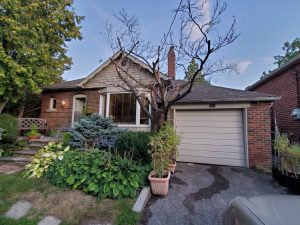
I am a long time member of TBG but this is my first garden help request so please let me know if this is not the right route.
I had a beautiful mature Japanese Maple that was very much the main feature at the front of my home in West Lansing (North York). Unfortunately btwn age (50+ yrs), the ice storms and severe cold winters it has died.
I’m not sure what type it was but I would like to replace it with a similar look (deep red leaves all season with a canopy over the garden and framing the picture window). However, as it’s quite close to the house, perhaps a variety that has a smaller trunk or multiple trunks would be better.
Please see attached pictures of the current tree.
I would greatly appreciate your advice on appropriate replacement options, as well as, recommendations for tree size and removal + installation care to ensure a healthy start.
Also, just fyi, my house is north facing with a 30-40′ Beech and young 20+’ Oak, each about 30-40′ away from the current tree to NE + NW respectively, and a 30′ mature cedar about 20-25′ E, which provide some protection from the N. Also, there is a mature Yew shrub at the base of the tree (approx. 4′ cube). There is room to locate the new tree to the side of this (instead of behind), or remove some of the Yew, so it would be1-2′ further from the house, and
complete removal of the old stump would not be required..
Thx for your help. Please let me know if you need any further info.
Regards,
Thank your for contacting Toronto Master Gardeners.
If you are looking for a replacement tree with deep red leaves all season, with a canopy over the garden and framing the picture window, and one that will tolerate shade, your choices are limited. Another Japanese maple (Acer palmatum) may be your best choice.
There are a myriad of Japanese maples on the market that come in sizes varying from 6-50 feet and a range of colours including the red you are looking for. They require well drained soil and partial sun and shade. Given your past success with this type of tree, your intended location likely meets these requirements.
With your tree requirements and site conditions established, visit your local nursery which should stock the Japanese maple varieties that are suited for your climate. The label on each tree should have information on the variety, its mature size, colour and what it requires to thrive. Store staff will be able to help you choose the best variety for your intended location.
Planting the tree correctly will allow it to establish quickly and grow well. There has been much research done in recent years on planting trees, and many of the old techniques have changed.
One of the most important steps is to ensure the tree is not planted too deep. The area where the main roots begin to branch off the trunk should be at ground level.
When planting, do not add any fertilizer, compost or new soil to the hole as you fill it in. Only refill the hole with the soil that was removed from the hole. This will encourage the tree roots to grow outward and stabilize the tree. If there is too much nutrition in the hole, the roots will stay in the high nutrition spot and your tree will not be stable or establish properly.
Lastly, when you plant the tree put a ring of mulch on the ground around the tree but do not place mulch right up against the trunk.
Water the tree slowly and deeply throughout the season whenever the soil dries out. Soaker hoses are great for this.
Here is our Garden Guide on tree planting: https://www.torontomastergardeners.ca/gardeningguides/planting-a-tree-a-toronto-master-gardeners-guide/
Good Luck!

